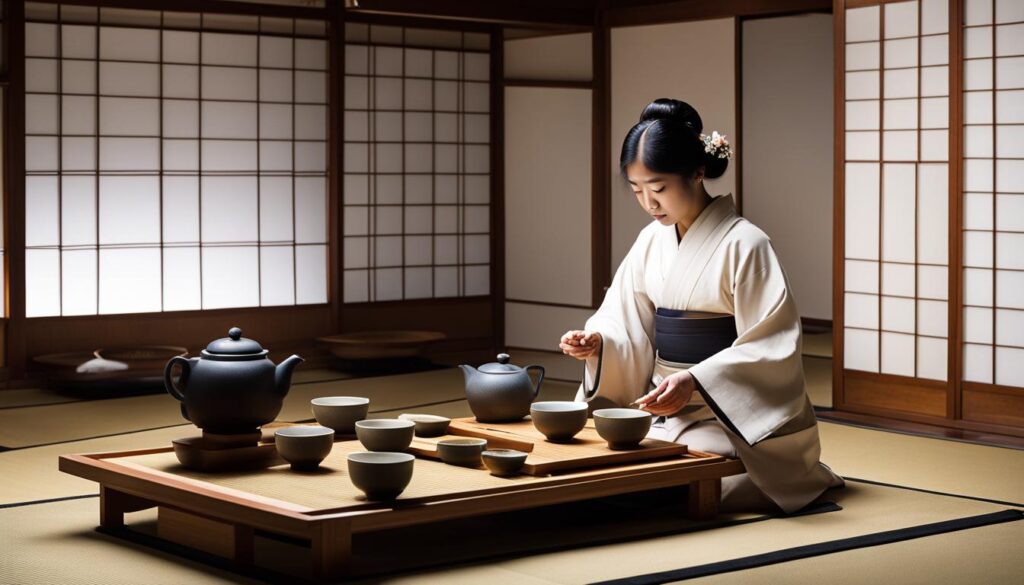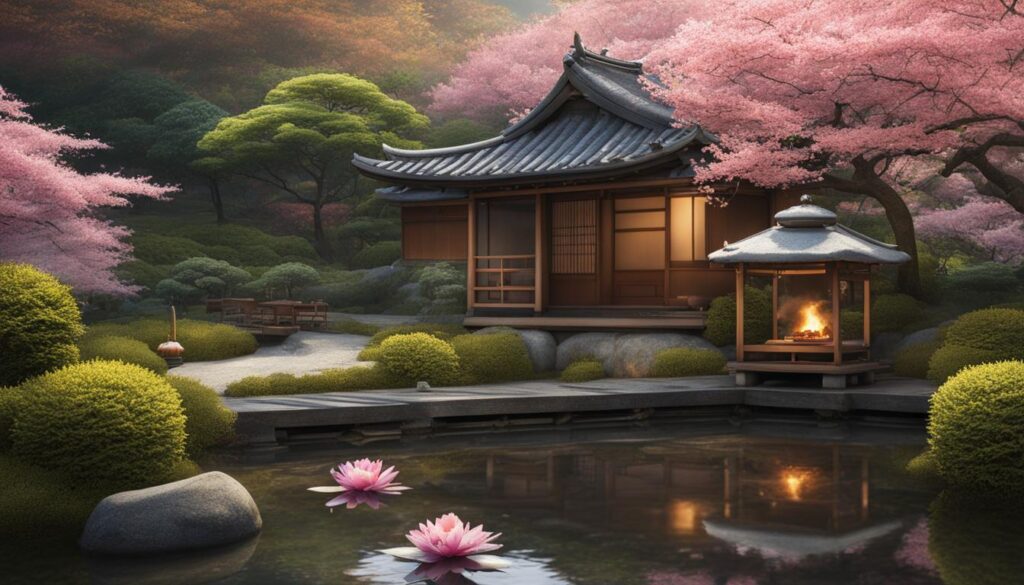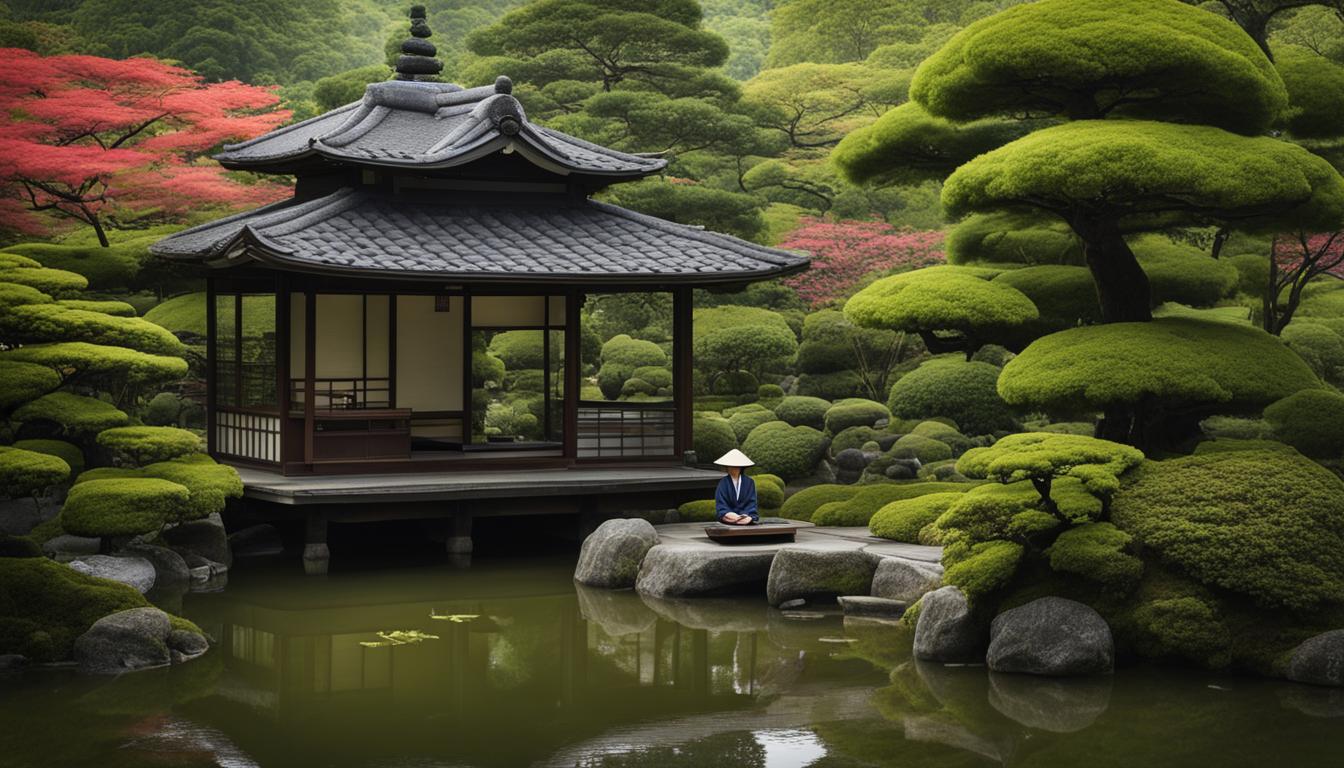Greetings! Welcome to our exploration of the captivating world of tea ceremonies. Today, we invite you to join us on a spiritual and philosophical journey as we delve deep into the rich traditions of Japanese and Chinese tea ceremonies.
What lies beyond the surface of brewing and drinking tea is a profound experience that encompasses harmony, respect, purity, and tranquility. The tea ceremony, known as sado or chanoyu, is a pathway to mindfulness, spirituality, and inner peace.
Let us embark on this enlightening adventure together as we uncover the essence of Zen Buddhism and Taoism in tea ceremonies. Discover how the principles of these ancient philosophies intertwine with the art of brewing tea, fostering a state of mindfulness and connecting us to a higher spiritual plane.
Are you ready to sip from the cup of wisdom and join us on this extraordinary journey? Let’s begin!
Key Takeaways:
- Tea ceremonies are not just about brewing and drinking tea; they embody harmony, respect, purity, and tranquility.
- The tea ceremony is deeply rooted in Zen Buddhism and Taoism, offering a path to mindfulness and inner peace.
- Zen Buddhism has greatly influenced the philosophical and aesthetic framework of the tea ceremony, emphasizing simplicity, mindfulness, and the present moment.
- Sen No Rikyu, a Japanese tea master, played a significant role in shaping the tea ceremony and its cultural impact on Japan.
- The four principles of the tea ceremony – Harmony, Respect, Purity, and Tranquility – guide every aspect and offer valuable life lessons.
The Zen Influence on Tea Ceremony Philosophy
Zen Buddhism has had a profound influence on the philosophy and practice of tea ceremonies. The core principles of Zen, such as simplicity, mindfulness, and living in the present moment, align perfectly with the essence of the tea ceremony. In fact, the ceremony itself becomes a form of meditation, where every action is performed with full attention and awareness.
The tea room, often minimalist and free from distractions, serves as a sanctuary for cultivating inner peace and tranquility. By immersing ourselves in the ritual of preparing and serving tea, we learn to appreciate the beauty of simplicity and the importance of being fully present in the moment. The tea ceremony embodies the harmony between the self and nature, creating a serene and contemplative atmosphere.
As a ritual, the tea ceremony encourages participants to embrace the principles of harmony, respect, purity, and tranquility. Each movement, from the precise preparation of the tea utensils to the graceful serving of the tea, is carried out with mindfulness and intention. Through this ritualistic practice, we not only deepen our connection with ourselves but also cultivate a deeper appreciation for the world around us.
Tea Ceremony Harmony Principles
| Principle | Description |
|---|---|
| Harmony (Wa) | The principle of harmony emphasizes the balanced relationship between the self, others, and the natural world. It encourages us to find unity and balance in our interactions and surroundings. |
| Respect (Kei) | Respect is at the core of the tea ceremony. It teaches us to honor others, their presence, and the objects we use in the ceremony. Mutual respect cultivates an atmosphere of appreciation and mindfulness. |
| Purity (Sei) | Purity represents the clarity of mind and spirit. Through the tea ceremony, we strive to purify our thoughts, actions, and intentions, creating a space for inner reflection and tranquility. |
| Tranquility (Jaku) | Tranquility is the state of calmness and serenity that we aim to achieve in the tea ceremony. By embracing stillness and quietude, we create an environment conducive to inner peace and self-discovery. |
The tea ceremony is not just a cultural practice; it is a way of life. By incorporating the Zen principles of mindfulness, simplicity, and living in the present moment, we can bring the wisdom of the tea ceremony into our daily lives. Whether it’s taking a moment to mindfully brew and savor a cup of tea or applying the principles of harmony, respect, purity, and tranquility in our interactions, the tea ceremony offers a path to profound personal growth and spiritual awakening.
The Legacy of Sen No Rikyu in the Tea Ceremony
Sen No Rikyu, hailed as the master of the Japanese tea ceremony, has left an indelible mark on the cultural and spiritual landscape of Japan. His teachings and practices continue to resonate, offering profound life lessons and shaping the way we approach the tea ceremony today. Rikyu’s influence extends far beyond the realm of brewing and drinking tea; it encompasses a deeper understanding of harmony, respect, purity, and tranquility.
Rikyu’s legacy in the tea ceremony can be seen in the way it has become a vehicle for spiritual and personal growth. The ceremony is not simply a social gathering or an artistic expression; it is a profound practice that allows participants to cultivate mindfulness and connect with the present moment. Through Rikyu’s teachings, individuals can learn the value of harmony in their interactions with others, the importance of showing respect, and the need for purity of mind and body.
The impact of Rikyu’s philosophy extends beyond the tea room and into everyday life. The tea ceremony serves as a powerful reminder to approach each moment with intention and mindfulness. It teaches us to appreciate the beauty in simplicity, to find tranquility amidst chaos, and to seek harmony in all aspects of our lives. Rikyu’s teachings encourage us to pause, reflect, and connect with our inner selves, ultimately leading to a deeper sense of spirituality and inner peace.
In summary, Sen No Rikyu’s legacy in the tea ceremony is one of great cultural impact and spiritual significance. His teachings continue to inspire individuals to embrace the principles of harmony, respect, purity, and tranquility not only during the ceremony but also in their daily lives. Through the tea ceremony, we can learn valuable life lessons that transcend the boundaries of culture and time, fostering personal growth, and a deeper connection to ourselves and others.

The Legacy of Sen No Rikyu
- Rikyu’s teachings have had a lasting cultural impact on Japan
- The tea ceremony is a path to spiritual awakening and mindful living
- Participants can learn life lessons about harmony, respect, purity, and tranquility
- The tea ceremony serves as a reminder to approach each moment with mindfulness
- Rikyu’s philosophy encourages simplicity, tranquility, and inner peace
The Four Principles of the Tea Ceremony
The tea ceremony is guided by four fundamental principles that serve as the philosophical framework for this deeply spiritual practice. These principles, rooted in Zen and Taoist philosophies, offer valuable life lessons and promote harmony, respect, purity, and tranquility.
Harmony (Wa)
The first principle of the tea ceremony is harmony, represented by the Japanese word “Wa.” It emphasizes the importance of creating a harmonious atmosphere where all participants can come together in unity. This principle extends beyond the physical environment and encompasses the harmonious interaction between the host and guests, as well as the harmony between the tea utensils, the tea itself, and the surroundings.
Respect (Kei)
Respect, or “Kei” in Japanese, is a core principle of the tea ceremony. It emphasizes the virtue of showing respect towards others, oneself, and the natural world. Participants in the tea ceremony demonstrate respect through their actions, such as bowing to each other, handling the tea utensils with care, and appreciating the beauty and significance of each element of the ceremony.
Purity (Sei)
Purity, known as “Sei” in Japanese, represents the importance of purity in both physical and mental aspects. It encourages participants to purify their minds and bodies, letting go of distracting thoughts and striving for a state of clarity and tranquility. The tea ceremony often takes place in a clean and minimalistic environment, symbolizing the purity of the space and the intention to cultivate inner purity.
Tranquility (Jaku)
The final principle of the tea ceremony is tranquility, represented by the Japanese word “Jaku.” It encourages participants to find inner peace and tranquility through the practice of mindfulness and the appreciation of the present moment. The serene and peaceful atmosphere created during the ceremony allows participants to let go of stress and distractions, enabling them to fully immerse themselves in the experience.
By embracing these principles, participants can not only deepen their understanding and appreciation of the tea ceremony but also apply the wisdom gained to their everyday lives. The tea ceremony serves as a reminder to cultivate harmony, show respect, strive for purity, and seek tranquility, leading to a more mindful and fulfilling existence.
Incorporating Tea Ceremony Principles in Daily Life
The principles of the tea ceremony extend far beyond the confines of the traditional ritual. They offer valuable insights and lessons that can be applied to our daily lives, promoting mindfulness, personal growth, and a greater sense of inner peace.
Mindfulness is at the core of the tea ceremony, and it can be woven into our daily routines. Taking a moment to savor a cup of tea, just like in the ceremony, can serve as a powerful reminder to be present in the moment and appreciate the simple joys of life. By incorporating mindfulness into our daily activities, we can cultivate a deep sense of awareness and gratitude.
The tea ceremony also teaches us the importance of harmony and respect. In our interactions with others, whether it be with family, friends, or colleagues, we can strive to create harmony and show respect, just as participants do in the ceremony. This can foster stronger relationships, enhance communication, and create a more peaceful and harmonious environment.
Furthermore, the tea ceremony teaches us about the value of purity and tranquility. We can seek purity of mind and body by engaging in self-reflection and practicing self-care. Taking time for solitude, meditation, or engaging in activities that bring us joy can help us attain a state of tranquility and inner peace.
By embracing these principles in our daily lives, we can bring the wisdom and essence of the tea ceremony into our everyday activities, fostering mindfulness, promoting harmonious relationships, and nurturing our well-being.

The Steps of a Typical Tea Ceremony
The tea ceremony is a meticulously choreographed ritual that involves several steps, each imbued with mindfulness and intention. From the preparation of the tea utensils to the serving and consumption of the tea, every action is performed with utmost care and focus. Let’s explore the steps of a typical tea ceremony:
Gathering and Preparation
The ceremony begins with the gathering of participants in a serene and tranquil tea room. The host, known as the “teishu,” meticulously arranges the tea utensils, including the tea bowl, tea whisk, tea caddy, and bamboo ladle. The utensils are chosen with precision and aesthetic sensitivity, enhancing the overall ambiance of the ceremony.
Boiling the Water
Once the utensils are prepared, the teishu boils water in a cast-iron kettle known as a “kama.” The water is heated to a specific temperature, depending on the type of tea being served. Boiling the water is seen as a meditative process, symbolizing the transformation of potential energy into active energy.
Whisking the Matcha Tea
The teishu carefully measures the matcha tea powder and places it in the tea bowl. Hot water is then added to the bowl, and the teishu uses a bamboo whisk to vigorously whisk the tea until it becomes frothy. This process, known as “chawan-watashi,” requires skill and precision, ensuring the tea is properly mixed and aerated.
Serving and Consumption
Once the tea is whisked to perfection, the teishu serves it to the guests, one by one. The tea bowl is passed from the teishu to the first guest, who receives it with both hands as a gesture of respect. The guest then rotates the bowl before taking a sip, appreciating the craftsmanship and beauty of the bowl. Each guest follows the same ritual, creating a sense of harmony and shared experience.
The tea ceremony is a profound practice that encourages mindfulness, meditation, and a deep appreciation for the present moment. By engaging in each step of the ceremony with mindfulness and intention, participants can cultivate inner peace and connect with the essence of the tea. Through this ritual, the tea ceremony becomes a transformative experience, offering a moment of respite and reflection in our busy lives.
Conclusion
The tea ceremony is not just about a simple cup of tea; it is a profound cultural practice that holds immense wisdom and meaning. Throughout this article, we have explored the mindfulness, life lessons, and cultural impact that the tea ceremony encompasses. By embracing the principles of harmony, respect, purity, and tranquility, we can truly experience the transformative power of this ancient ritual.
One of the key takeaways from the tea ceremony is mindfulness. By being fully present in each moment, we can cultivate a sense of awareness and appreciation for the beauty of life. Whether we are participating in a formal ceremony or simply taking moments to brew and drink tea mindfully, we can bring a sense of tranquility and peace into our daily lives.
The tea ceremony also offers valuable life lessons. The principles of the tea ceremony encourage us to strive for harmony, show respect to others, seek purity of mind and body, and achieve a state of tranquility. By incorporating these principles into our everyday actions, we can lead a more mindful and fulfilling life.
Lastly, the tea ceremony has a profound cultural impact. It not only preserves ancient traditions but also promotes cultural awareness and a deeper connection to ourselves and others. The tea ceremony serves as a reminder of the importance of preserving our heritage and embracing diverse cultural practices.
FAQ
What is the tea ceremony?
The tea ceremony, also known as sado or chanoyu, is an ancient practice that goes beyond just brewing and drinking tea. It is a spiritual and philosophical exercise that embodies the principles of harmony, respect, purity, and tranquility.
How does Zen Buddhism influence the tea ceremony?
Zen Buddhism emphasizes simplicity, mindfulness, and living in the present moment, which are all reflected in the tea ceremony. It becomes a form of meditation where every action is performed with full attention and mindfulness.
Who is Sen No Rikyu?
Sen No Rikyu was a Japanese tea master who played a crucial role in shaping the tea ceremony into its highly ritualized form. His teachings and practices have had a lasting cultural impact on Japan and the tea ceremony.
What are the four principles of the tea ceremony?
The four principles of the tea ceremony are harmony (Wa), respect (Kei), purity (Sei), and tranquility (Jaku). These principles serve as the philosophical compass for every aspect of the ceremony and are deeply rooted in Zen and Taoist philosophies.
How can the principles of the tea ceremony be applied to daily life?
By practicing mindfulness, cultivating harmony, showing respect to others, striving for purity of mind and body, and seeking tranquility, individuals can bring the wisdom and essence of the tea ceremony into their daily activities. Each principle offers guidance for living a mindful and fulfilling life.
What are the steps of a typical tea ceremony?
A typical tea ceremony consists of several steps that are carefully executed with mindfulness and intention. It starts with the preparation of tea utensils and boiling water, followed by the whisking of matcha tea. The tea is then served to guests, who rotate the bowl before taking a sip. The ceremony concludes with the cleaning of utensils.





